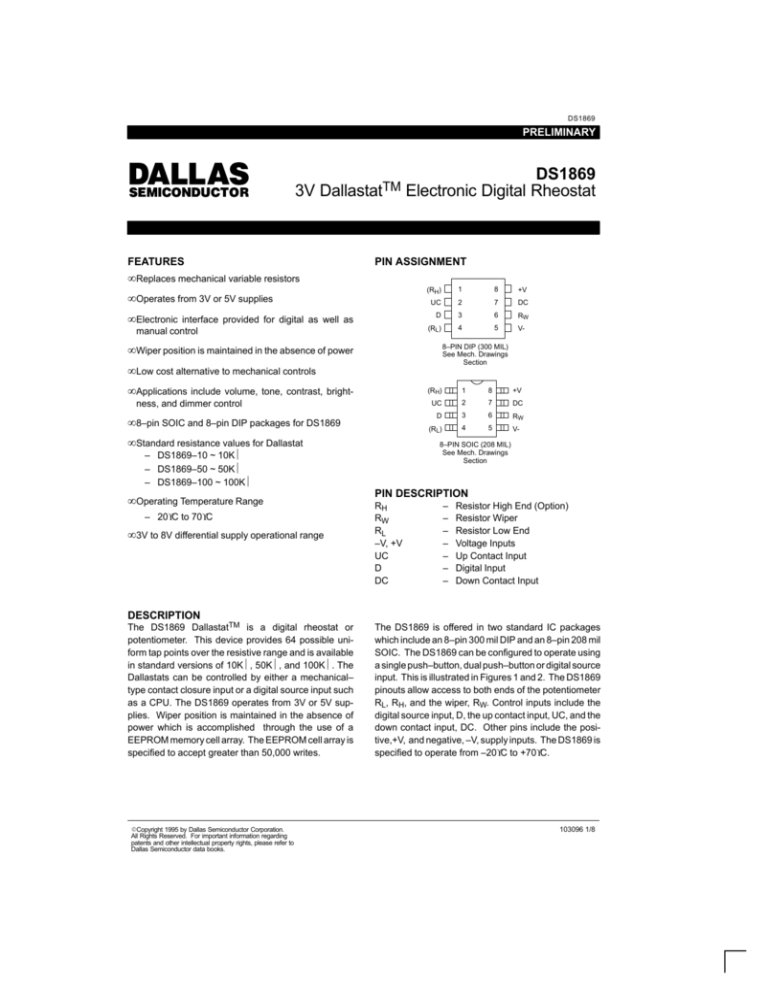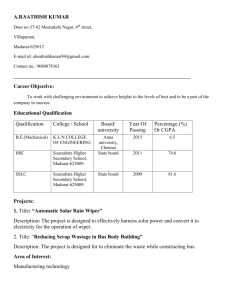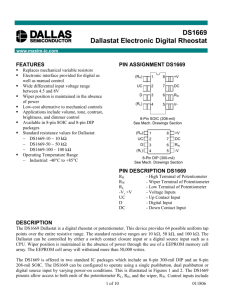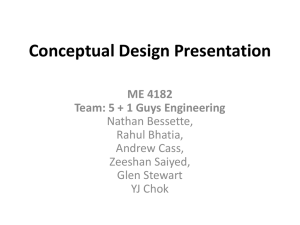
DS1869
PRELIMINARY
DS1869
3V DallastatTM Electronic Digital Rheostat
FEATURES
PIN ASSIGNMENT
• Replaces mechanical variable resistors
• Operates from 3V or 5V supplies
• Electronic
interface provided for digital as well as
manual control
(RH)
1
8
+V
UC
2
7
DC
D
3
6
RW
(RL)
4
5
V-
• Wiper position is maintained in the absence of power
8–PIN DIP (300 MIL)
See Mech. Drawings
Section
• Low cost alternative to mechanical controls
• Applications
include volume, tone, contrast, brightness, and dimmer control
• 8–pin SOIC and 8–pin DIP packages for DS1869
• Standard resistance values for Dallastat
– 20°C to 70°C
• 3V to 8V differential supply operational range
1
8
+V
UC
2
7
DC
D
3
6
RW
(RL)
4
5
V-
8–PIN SOIC (208 MIL)
See Mech. Drawings
Section
– DS1869–10 ~ 10KΩ
– DS1869–50 ~ 50KΩ
– DS1869–100 ~ 100KΩ
• Operating Temperature Range
(RH)
PIN DESCRIPTION
RH
RW
RL
–V, +V
UC
D
DC
–
–
–
–
–
–
–
Resistor High End (Option)
Resistor Wiper
Resistor Low End
Voltage Inputs
Up Contact Input
Digital Input
Down Contact Input
DESCRIPTION
The DS1869 DallastatTM is a digital rheostat or
potentiometer. This device provides 64 possible uniform tap points over the resistive range and is available
in standard versions of 10KΩ, 50KΩ, and 100KΩ. The
Dallastats can be controlled by either a mechanical–
type contact closure input or a digital source input such
as a CPU. The DS1869 operates from 3V or 5V supplies. Wiper position is maintained in the absence of
power which is accomplished through the use of a
EEPROM memory cell array. The EEPROM cell array is
specified to accept greater than 50,000 writes.
Copyright 1995 by Dallas Semiconductor Corporation.
All Rights Reserved. For important information regarding
patents and other intellectual property rights, please refer to
Dallas Semiconductor data books.
The DS1869 is offered in two standard IC packages
which include an 8–pin 300 mil DIP and an 8–pin 208 mil
SOIC. The DS1869 can be configured to operate using
a single push–button, dual push–button or digital source
input. This is illustrated in Figures 1 and 2. The DS1869
pinouts allow access to both ends of the potentiometer
RL, RH, and the wiper, RW. Control inputs include the
digital source input, D, the up contact input, UC, and the
down contact input, DC. Other pins include the positive,+V, and negative, –V, supply inputs. The DS1869 is
specified to operate from –20°C to +70°C.
103096 1/8
DS1869
OPERATION
The DS1869 can be configured to operate from a single
contact closure, dual contact closure inputs or driven
using a digital source input. Figures 1 and 2 illustrate
both configurations, respectively. Contact closure is
defined as the transition from a high level to a low level
on the up contact (UC), down contact (DC), or digital
source (D) inputs. These inputs are inactive when in the
high state.
The DS1869 interprets input pulse widths as the means
of controlling wiper movement. A single pulse input over
the UC, DC, or D input terminals will cause the wiper
position to move 1/64th of the total resistance. A transition from a high to low on these inputs is considered the
beginning of pulse activity or contact closure. A single
pulse is defined as being greater than 1 ms but lasting
no longer than one second. This is shown is Figures 3,
4, and 5 (a).
Repetitive pulsed inputs can be used to step through
each resistive position of the device in a relatively fast
manner (see Figure 5b). The requirement for repetitive
pulsed inputs is that pulses must be separated by a
minimum time of 1 ms. If not, the DS1869 will interpret
repetitive pulses as a single pulse.
Pulse inputs lasting longer than one second will cause
the wiper to move one position every 100 ms following
the initial one second hold time. The total time to transcend the entire potentiometer using a continuous input
pulse is given by the formula below:
1 second + 63 X 100 ms = 7.3 (seconds)
Single contact closure operation allows the user to control wiper movement in either direction from a single
push–button input. Figure 1 presents a typical single
push–button configuration. The UC input is used to
increment and decrement wiper position for single
push–button mode of operation. The DC input provides
no functionality in this mode but must be connected to
the positive supply voltage (VCC). The digital source
input (D) can be allowed to float.
On device power–up, the configuration shown in
Figure 1 must exist in order to enter the single contact
closure mode of operation; especially and specifically,
the (DC) input’s connection to the positive supply voltage (VCC).
103096 2/8
The direction of wiper movement, in single push–button
operation, is determined by prior activity; with the direction of wiper movement being opposite to that of the previous activity.
Changing the direction of wiper movement in single
push–button mode is accomplish by a period of inactivity on the UC input of a (minimum) one second or
greater. Also, in single push–button mode, as the wiper
reaches the end of the potentiometer range its direction
of movement reverses. This will occur, regardless, if
the input is a continuous pulse, a sequence of repetitive
pulses or a single pulse.
The digital source input, D, was designed for microprocessor or controlled applications. This control input manipulates the device in the same manner as the single
push–button configuration; controlling movement of the
wiper position in both upward and downward directions.
One added feature over the single push–button configuration is the ability to increment or decrement wiper
position at a faster rate. Digital source input control is
available regardless of the type of push–button configuration.
Dual push–button mode of operation is accomplished
when the DC input is floated on power–up. If interfacing
contact closure control inputs to digital logic, the DC
input must be interfaced to an open drain drive which is
high impedance during power–up, see Figure 2B. This
will prevent the device from entering a single push–button mode of operation.
In dual push–button mode, each direction is controlled
by the up contact (UC) and down contact (DC) inputs,
respectively. No wait states are required to change
wiper direction in dual push–button mode. In dual
push–button mode, as the wiper position reaches the
end of the potentiometer, the direction of wiper movement will not change. Wiper position will remain at the
potentiometers’ end until an opposite direction input is
given.
All contact closure control inputs, UC, DC, and D are
internally pulled–up by a 100KΩ resistance. The UC
and DC inputs are internally debounced and require no
external components for input signal conditioning.
DS1869
DS1869 SINGLE PUSH–BUTTON CONFIGURATION (TYPICAL EXAMPLE) Figure 1
DS1869
CPU
(OPTIONAL)
RH
V+
UC
DC
D
RW
RL
V–
DS1869 DUAL PUSH–BUTTON CONFIGURATION (TYPICAL EXAMPLE) Figure 2A
DS1869
CPU
(OPTIONAL)
RH
V+
UC
DC
D
RW
RL
V–
103096 3/8
DS1869
DS1869 DUAL PORT CONFIGURATION (TYPICAL EXAMPLE) Figure 2B
DS1869
(PORT CONTROL)
103096 4/8
RH
V+
UC
DC
D
RW
RL
V–
(PORT CONTROL)
DS1869
The DS1869 is provided with two supply inputs –V and
+V. The maximum voltage difference between the two
supply inputs is +8.0 volts while the minimum voltage
difference is +2.7 volts. All input levels are referenced to
the negative supply input, –V. The voltage applied to
any Dallastat terminal must not exceed the negative
supply voltage (–V ) by –0.5 or the positive supply voltage (+V) by +0.5 volts. The minimum logic high level
must be +2.4 volts with reference to the –V supply voltage input for +V=5V. A logic low level with reference to
the –V supply voltage has a maximum value of
+0.8 volts. Dallastats exhibit a typical wiper resistance
of 400 ohms with a maximum wiper resistance of
1000 ohms. The maximum wiper current allowed
through the Dallastat is specified at 1 milliamps (see DC
Electrical Characteristics).
NONVOLATILE WIPER SETTINGS
Dallastats maintain the position of the wiper in the
absence of power. This feature is provided through the
use of EEPROM type memory cell arrays. During normal operation the position of the wiper is determined by
the input multiplexer. Periodically, the multiplexer will
update the EEPROM memory cells. The manner in
which an update occurs has been optimized for reliability, durability, and performance. Additionally, the update
operation is totally transparent to the user.
When power is applied to the Dallastat, the wiper setting
will be the last recorded in the EEPROM memory cells.
If the Dallastat setting is changed after power is applied,
the new value will be stored after a delay of 2 seconds.
The initial storage of a new value after power–up occurs
when the first change is made, regardless of when this
change is made.
After the initial change on power–up all subsequent
changes of the wiper position will be recorded only, if the
LSB (out of a 6–bit total for 64 position) is being
changed. Thus any change greater than 12.5% of the
total resistance range will trigger one EEPROM write
cycle. Changes smaller than 12.5% will be recorded
only when the fourth LSB is toggled.
Changes or storage to the EEPROM memory cells must
allow for a 2 second delay to guarantee that updates will
occur. The EEPROM memory cells are specified to
accept greater that 50,000 writes before a wear–out
condition. If the EEPROM memory cells do reach a
wear–out condition, the Dallastat will still function properly while power is applied. However, on power–up the
device’s wiper position will be that of the position last
recorded before memory cell wear out.
FLOWCHART: ONE BUTTON OPERATION AND ELECTRICAL CONTROL Figure 3
CONTACT CLOSURE
(D OR UC)
INCREMENT/DECREMENT
1/64TH
NO
CONTACT CLOSED
CONTINUOUSLY
> 1 SEC ?
NO
LIMIT REACHED
OR
CONTACT OPEN
1 SEC ?
YES
REVERSE DIRECTION
YES
INCREMENT/DECREMENT
ON 100MS INTERVALS
CONTACT OPEN AND CONTACT CLOSURE TIMING IS one second ± 15%
103096 5/8
DS1869
FLOWCHART: TWO BUTTON OPERATION Figure 4
CONTACT CLOSURE
UC
UC OR DC?
DC
YES
AT UPPER
LIMIT?
YES
BOTH CONTACTS
OPEN?
YES
NO
NO
INCREMENT
1/64TH
CONTACT CLOSED
CONTINUOUSLY
>1 SEC?
DECREMENT
1/64TH
NO
NO
DECREMENT ON
100MS INTERVALS
INCREMENT ON
100MS INTERVALS
AT UPPER
LIMIT?
YES
CONTACT OPEN AND CONTACT CLOSURE TIMING IS one second ± 15%
103096 6/8
CONTACT CLOSED
CONTINUOUSLY
>1 SEC?
YES
YES
NO
AT LOWER
LIMIT?
YES
AT LOWER
LIMIT?
NO
DS1869
ABSOLUTE MAXIMUM RATINGS*
Voltage on Any Pin Relative to -V
Operating Temperature
Storage Temperature
Soldering Temperature
–V –0.5V +8.0V
–20°C to +70°C commercial
–55°C to +125°C
260°C for 10 seconds
* This is a stress rating only and functional operation of the device at these or any other conditions above those
indicated in the operation sections of this specification is not implied. Exposure to absolute maximum rating
conditions for extended periods of time may affect reliability.
(0°C to 70°C)
RECOMMENDED DC OPERATING CONDITIONS
PARAMETER
SYMBOL
MIN
MAX
UNITS
+ Supply Voltage
+V
–V + 2.7
–V + 8.0
V
– Supply Voltage
–V
+V – 8.0
+V – 2.7
V
RH,RW,RL
–V – 0.5
+V + 0.5
V
Logic Input 1
VIH
+2.4
Logic Input 0
VIL
Wiper Current
IW
Resistor Inputs
TYP
SYMBOL
+, – Supply Current
ICC1
Supply Current, Idle State
At 3.3V
At 8.0V
ICC2
Wiper Resistance
RW
MIN
1, 2, 10
+0.8
V
1, 2, 10
1
mA
5
TYP
MAX
UNITS
NOTES
1
2
mA
3
2
10
µA
9
1000
Ω
400
(0°C to 70°C; -V to+V = 2.7V to 8.0V)
AC ELECTRICAL CHARACTERISTICS
PARAMETER
V
(0°C to 70°C; -V to +V = 2.7V to 8.0V)
DC ELECTRICAL CHARACTERISTICS
PARAMETER
NOTES
SYMBOL
MIN
MAX
UNITS
NOTES
Input Pulse Width (D–input)
tPW
1
DC
µs
1, 7, 8
Contact Pulse Width
(UC, DC inputs)
tCPW
1
DC
ms
1, 7, 8
10
pF
6
Capacitance
CIN
TYP
5
Repetitive Input Pulse High Time
tHPW
1
DC
ms
1, 7, 8
Continuous Input Pulse
tCCP
1
DC
s
1, 7, 8
103096 7/8
DS1869
TIMING DIAGRAMS Figure 5
(A) SINGLE PULSE INPUTS
tPW
tCPW
VIH
VIL
(B) REPETITIVE PULSE INPUTS
tCPW
tHPW
VIH
VIL
(C) CONTINUOUS PULSE INPUTS
tCCP
VIH
VIL
NOTES:
1. All inputs; UC, DC, and D are internally pulled up with a resistance of 100KΩ.
2. Input logic levels are referenced to –V.
3. ICC is the internal current that flows between –V and +V.
4. Input leakage applies to contact inputs UC and DC and the digital input (D).
5. Wiper current current is the maximum current which can flow through the wipers.
6. Capacitance values apply at 25°C.
7. Input pulse width is the minimum time required for an input to cause an increment or decrement. If the UC,DC,
or D input is held active for longer than one second, subsequent increments or decrements will occur on 100 ms
intervals until the inputs UC, DC, and/or D is released to VIH.
8. Repetitive pulsed inputs on UC, DC, or D will be recognized as long as the pulse repetition occurs within 1 second
of each other. Pulses occurring faster than 1 ms apart may not be recognized as individual inputs but can be interpreted a constant input. Tolerances for pulse timing is ±15% on minimum inputs.
9. Idle state supply current is measured with no push–button pressed and with the wiper RW tied to a CMOS
load.
10. For +V referenced to –V = 5V.
103096 8/8








